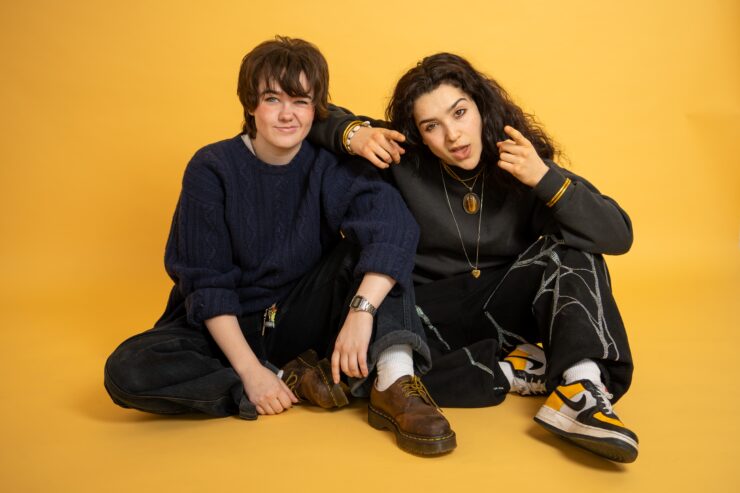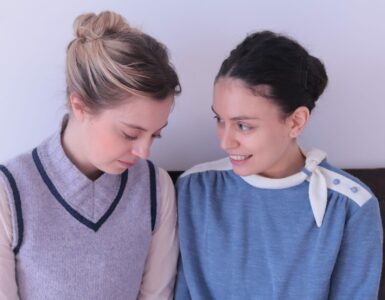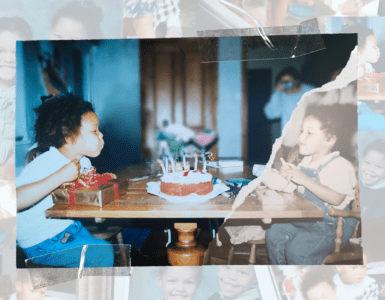From their remarkable breakthrough performing their debut comedic Western show How the Rodeo Burnt Down at the Edinburgh Festival Fringe in 2022, through to earning their stripes with their third consecutive Scotsman Fringe First Award this past year with Boy Scout Patriotism deep-dive A Letter to Lyndon B. Johnson or God: Whoever Sees This First, there are few Fringe artists who have seen such a stratospheric rise to popularity as Xhloe and Natasha.
The pair’s trademark style mixing high energy, seamless, clowning physicality with absurdist storytelling exploring dark themes has landed them a tour on both sides of the pond, and they now stand poised to bring all three shows back to their festival of origin as part of Edinburgh Festival Fringe later this summer.
Ahead of the pair’s dual run of aforementioned A Letter to Lyndon B… and surreal exploration of American womanhood What If They Ate the Baby? at London’s Soho Theatre later this month, we managed to find time in the duo’s incredibly busy schedule to catch up for a pixelated pint. Join us here in the Binge Fringe Virtual Pub as we dive into both shows, and the realities of touring across the Atlantic.
You can catch both shows at the Soho Theatre Dean Street on alternating dates between Monday 17th and Saturday 29th March at 6:45pm (60mins). Tickets are available through the Venue’s Online Box Office.
Jake: Hi Xhloe and Natasha! We last caught up with you when we saw A Letter to Lyndon B… on stage at EdFringe, since then you’ve taken home your third Fringe First Award in a row. Tell us a bit about what you’ve been up to – and whether you’re still riding that high.
X&N: I think it’s safe to say we’re still riding that high. We don’t even think the first time we won has really sunk in, we sometimes get told “three fringe firsts? You know that’s crazy right?” and we have to take a second to remind ourselves that it really is. Post-Fringe we headed straight to London to transfer the production there. We had a blast but adding more performances onto the end of Fringe is not for the weak. It was awesome getting to see a bunch of people who couldn’t make it to Fringe but we slept for almost a week when we got back in late September.
We then took some time to take stock, recover, and plan for the next year. One of the perks of the success that we’ve had is that load of people from across the world started reaching out to us. From Texas to London to South Korea, we’ve had small theatres saying they’d seen us or heard of us and asking how they can get us there. That’s so exciting for us because we’ve always felt our shows would have a life outside of Fringe, and the idea of getting our shows to people without the resources to get to Edinburgh in August is a bonus.
In February, we had the opportunity to do an Off-Broadway run of “A Letter To LBJ” at Soho Playhouse in our home city of New York as part of the International Fringe Encore Series. It was so great to get to properly share this piece with our friends and family but we were also so surprised with the difference we felt playing a show like this to a predominantly American audience. The laughs were different, the reference hit at different times, certain lines pop out more significantly than others, it keeps us on our toes but also keeps us constantly learning about and questioning our show and how to make it the best it can be.
Jake: Lyndon B. explores 1960s America through the lens of two boy scouts. Tell me a bit about them, creating them, and playing them.
X&N: This show follows Ace and Grasshopper. Ace refers to himself as “highly decorated”, as he is, in many ways, a model scout. The youngest of seven brothers and the son of a Staff Sergeant, Ace has everything about being a boy “on lock”: spit shakes, scraped knees, and being really really tough. As the show goes on we see Ace’s hard exterior begin to crack and he lets the audience in on the complicated fearful yet admiring relationship he has with his father, and his tendency to freeze up in the face of conflict. Contrasting him is Grasshopper, an only child raised by his lone grandmother who pridefully describes himself as “gentle spirited” and who, despite not having a father, reckons if he did, he would definitely be a soldier.
Grasshopper is the more timid of the two, manifesting itself in his difficulty with speech to his lack of physical strength. He looks up to Ace who serves as a guide into boyhood for him, something he feels wholly on the outside of but wholly willing to learn the ropes. Both boys see their president as a paternal figure, a protector, and to a certain extreme, a God. When there’s no one else to point to, they point to LBJ as their protector and will stop at nothing to make him proud.
We both have spent years in New York working with kids, tutoring math, teaching robotics after school, nannying, and even catching kids flying off of BMX bikes at an indoor skate park. While Ace and Grasshopper are not inspired by any two kids in particular, it was watching our students interact, tell stories, and deal with conflict that helped us create our characters as real people. When you’re young, everything feels big, everything feels real, and all the adult things like dealing with friendship, feelings, and your own identity have to happen at the same time that you’re learning how to be a human at all.
We wanted our scouts to not only feel like real children, but to be real people too. The show is super clowney, exaggerated, and high energy, but on our end the characters are as 360 degrees as we would approach a Chekhov or Shakespeare text, and we think it shines through. We hear from audience members that they feel like they know them, that they grew up with kids just like that. We think everyone can see a little bit of themself in one or both of them.
Playing them is the most fun part, part of our pre-show ritual with this show is reminding each other that we get to go play. This show feels like going outside and playing pretend with your friends in your neighborhood, and we never want to lose that. It’s been so fun to see the characters’ physicalities emerge and sharpen the longer we do the shows. We’ve even begun to notice ways in which Grasshopper’s physicality is slowly starting to incorporate aspects of how Ace moves or gesticulates, as though he admires him so much he’s even trying to act like him too.
Jake: What If They Ate The Baby? takes a look at the archetype of the 1950s American Housewife through a pretty sideways lens. Tell me all about green spaghetti and double entendre.
X&N: There’s always something uneasy about the green spaghetti, even though, spoiler alert, it’s just pasta and food dye. We’ve even had audiences have an audible reaction to us taking a bite, which is how we know the spaghetti is doing its job. The post war period in America was a booming time for all sorts of “easy” new recipes that would make the life of the housewife easier, one of our grandmother recalls “spaghetti casserole” popular at the time, exotic sounding even. We wanted the show to center around a dish in the way the life of the wife surrounded food, preparing it, cleaning it, in some cases, producing it with their own bodies.
The housewife herself was a consumable in a way, and audiences view eating on stage differently than in other settings. A bite of spaghetti that would otherwise seem harmless suddenly becomes uneasy, suspicious, and out of place. The green color helps remind the audience to question it.
The 1950s in America is marked by paranoia, the threat of communism had brothers turning on brothers, and neighbors turning on neighbors for things as simple as having modern art hung up or enjoying certain music. Because of this, this show is so much about what can and cannot be said. Pair that with the polite social attitudes of the time and double entendre becomes our best friend. The script itself of this show, we think, is actually quite a boring read for this reason.
The words say one thing but the audience knows another. This can extend from everything from “under the table” referring to something that is meant to be kept hidden but also a great place for an illicit love affair, to the concept of eating at all, on one hand a daily task and on the other a reference to sapphic sex and obsession, consuming your partner in every way possible. It’s because of this, we think, that many people find this show so rewatchable. What was witty banter on your first watch can actually spoil the end of the show on your second. It’s either that or that audiences are so confused they need another watch to clarify, either way, we’re not complaining.
Jake: You’re bringing both shows to the Soho Theatre in London, right off the bat of a run of Lyndon B. at the SoHo Playhouse in New York. How does it feel going from SoHo to Soho, and are you excited for it all?
X&N: We are definitely excited, and will be even more excited as soon as the soreness from the Soho NYC wears off. There are many perks to going quickly from one run to another, we are at our peak attentiveness to detail in the show, like an athlete in the middle of the season, but there’s also a bit of whiplash to have the curtain come down on an exciting run and be thrown right into having to focus on another.
The “Soho” and “Soho” coincidence has had our conversations, to do lists, and email inboxes quite confusing but we’re so excited to be making our Soho Theatre Debut in London. From our first trip to London we had been told our work was in line with a lot of the work there, and we’ve enjoyed so many shows there, we’re honored to be in the company of people we’ve admired and have followed for so long. We also hope this helps us to reach a new audience in London that maybe hasn’t heard of us before, there’s a lot of Fringe overlap in London of course, but we’re excited at the idea of branching out.
Jake: Given the themes of Binge Fringe, if these shows were a beverage of any kind (alcoholic, non-alcoholic – be as creative as you like!), what would they be and why?
X&N: If “A Letter to Lyndon B Johnson or God: Whoever Reads This First” was a drink it would have to be something outwardly fun, with a complex undertone that packs a punch at the end. Maybe a strong whiskey sour, but use honey to sweeten it, like the “bees” in the show. And smoke the bourbon, the more it tastes like the woods the better.
For “What If They Ate The Baby?” our first thought it has to be green somehow of course. Maybe a milk punch, like tea and rum and lemon washed with milk. The milk references the show, the tea feels super housewifey, and the idea of a milk clarified cocktail reminds us of the famously strange cuisine of the time period. Add some green food coloring while you’re at it.
You can catch both shows at the Soho Theatre Dean Street on alternating dates between Monday 17th and Saturday 29th March at 6:45pm (60mins). Tickets are available through the Venue’s Online Box Office.
Hear the latest from Marginalised Voices from Fringes across the World
Subscribe to our Email Newsletter so we can send you insightful updates about unheard creative voices working to platform powerful stories. You'll be the first to hear about our content and how to apply to have shows you're working on reviewed.
Powered by EmailOctopus









